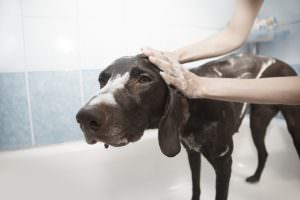
Grooming your dog is a crucial part of caring for them, and failing to do it can lower their quality of life. Grooming your dog regularly could even help save their life if you spot lumps, bumps, or disease-causing ticks. Taking your dog to the groomer can be time-consuming and expensive (but if you need a little outside help, here are some tips for finding the best groomer for your dog). Luckily, there are a lot of things you can do for your dog at home to help them look and feel their very best. Here are 5 essential grooming tips to improve your dog’s quality of life and dashing good looks!
#1 – Trim nails at least once a month
Did you know that the quick – a vein and nerve in the toenail – can grow longer when nails are left untrimmed? If you wait too long to trim your dog’s nails, you won’t be able to cut off much without cutting into the quick, which hurts and causes your dog to bleed. It’s best to trim nails at least once or twice a month. Nails that grow too long can cause arthritis. Some dogs (and their humans) prefer to have their nails filed by a grinder. By taking the layers of the nail off slowly with a nail grinder, you can get the nails shorter with less risk of making your dog bleed.
#2 – Use the right brush
Brushing your dog is great for bonding, reduces shedding, and helps you become familiar with every inch of your dog’s skin. Using the wrong brush on your dog can be ineffective at best and harmful at worst. These are the best tools for each coat type:
Short hair (Boxer, Labrador) – A rubber curry-style brush will gently remove loose hair and spread your dog’s natural oils through his coat. A deshedding tool can significantly reduce shedding, but it can also cause bald spots if overused.
Thick, shedding hair (German Shepherd, Golden Retriever) – A slicker brush combined with an undercoat rake should reduce shedding and prevent knots, called mats, from forming in your dog’s fur.
Fine or curly hair (Yorkie, Poodle) – A slicker brush or a pin brush along with a sturdy metal comb will be your best bets here. The longer your dog’s hair is, the more frequently you’ll need to brush it, as often as every day.
#3 – Only use dog shampoo
Not only can human shampoo be toxic for dogs, but it’s also too harsh for dog skin. You should always brush your dog before washing them with shampoo specifically designed for dogs, since water makes mats worse, though you can pick mats apart with your fingers while your dog is soaked in conditioner to make the mats somewhat easier to brush out after the bath (preferably after blow drying your dog since air drying will cause the mats to tighten again). Always rinse your dog thoroughly, since shampoo left in your dog’s coat can leave them itchy and flaky.
#4 – Check for parasites
Bath time is the best time to check your dog for fleas, ticks, and lice. Live fleas tend to run when they get wet, making them easier to see. Flea “dirt,” which is actually their excrement, will look like pepper flakes on your dog’s dry fur but will appear to bleed when wet. Ticks can look like moles or warts until you see tiny legs poking away from the tick’s body while their head is embedded in your dog’s skin. Lice can look like dirt or other debris attached to your dog’s coat or skin, but they won’t wash off no matter how hard you try with just regular shampoo.
#5 – Don’t forget eyes, ear, and teeth
You should regularly look at your dog’s eyes to check for tearing, redness, or cloudiness. Ears can be cleaned out with ear cleaner or witch hazel on a cotton ball. Any funky smell or discharge from your dog’s ears could indicate an infection and should be brought to your vet’s attention. Ideally, you should be brushing your dog’s teeth daily. If they won’t tolerate a toothbrush, try dental wipes, sprays, or treats.
(H/T: Cesar’s Way, ASPCA)
via Whisker Therapy




